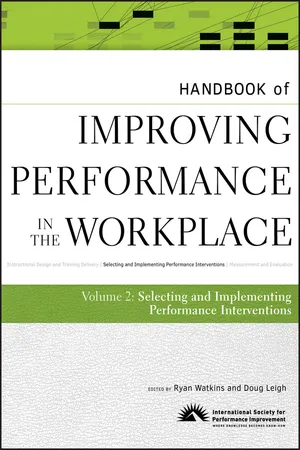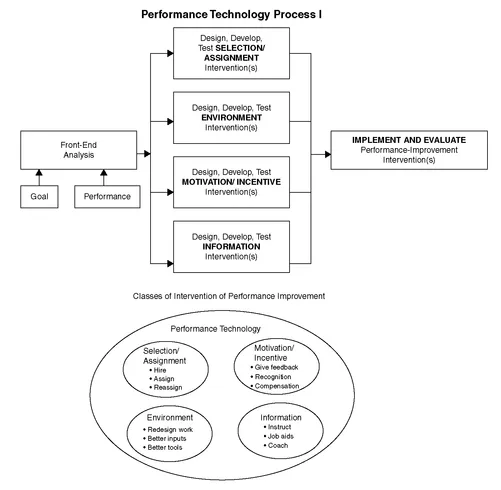![]()
PART ONE
INTRODUCTION
Before selecting and implementing any variety of performance interventions, it is important to consider the foundations on which the interventions will be built. Just as a shiny red sports car is only as fast as the engineering and design that went into it, the value created by improvement interventions is wholly dependent on the processes you use to design, develop, and implement them. From the initial planning that defines the strategic results to be accomplished to the final evaluations of performance and impact, performance improvement initiatives are best built on a solid foundation of systematic design.
Like other applied disciplines, performance improvement relies on a variety of models, theories, scientific processes, frameworks, taxonomies, and other building blocks to create this foundation. As a social science, performance improvement doesn’t have a single theory, model, or framework that can be applied in all situations; people are just too complex and unpredictable. Therefore, it’s necessary to put the pieces of the puzzle together for yourself each and every time you work to improve performance. Through (1) the application of procedural models derived on years of professional experience, (2) the use of pragmatic frameworks and taxonomies, and (3) the integration of scientific theories and findings, it’s possible to create systems that improve individual and organizational performance in a sustainable manner.
This type of improvement effort does not, however, lend itself well to quick-fixes or one-off solutions. Systemic improvements in performance are rarely the result of activities that focus either on just one element of the performance system (for example, isolating only the knowledge and skills of employees, the setting of expectations, or the use of targeted incentives) or on pre-selected solutions (be it training, coaching, or new software). Rather, it’s necessary to know first what results must be accomplished. Complex performance challenges of today’s organizations are not improved by disjointed or unconnected efforts.
Similarly, no single performance improvement theory, taxonomy, model, or research finding is going to do it all for your organization. It is therefore vital for professionals to identify and, as appropriate, apply multiple, varied models. Wile’s Synthesized Human Performance Technology (HPT) Model (see Figure 1.6), for instance, may provide a useful diagnostic tool for your situation. In addition, you might also want to use a procedural model, such as the traditional HPT process (see Figure 1.8), to guide your performance improvement activities. Then again, next year a new performance improvement opportunity may require that you apply different classification, diagnostic, or process models in order to accomplish sustainable results.
WHAT’S COMING UP
In Chapter One, HPT Models: An Overview of the Major Models in the Field, Frank Wilmoth and his colleagues provide an overview of numerous models, frameworks, and taxonomies for improving individual and organizational performance. Their chapter, first published in Performance Improvement Journal, illustrates the variations in approaches used to improve performance, the commonalities that help define performance improvement as a discipline, as well as the value of taxonomies for classifying the numerous performance interventions that are available to professionals when applying any model within their organizations.
The chapter explores the models of performance improvement by grouping them around (1) the models developed by “pioneers” in the discipline, (2) classification models, (3) diagnostic models, (4) process models, and (5) holistic models. This provides you a structure for comparing, contrasting, and identifying which combinations might be useful in differing situations. The models, frameworks, and taxonomies included in the chapter do not represent an exhaustive list. Rather, the authors provide an introduction to models that should drive performance improvement initiatives as a starting place that you can use to define your own approach to improving performance. In the Editorial Connections feature that follows the chapter, we highlight a few additional models and frameworks that can further guide your improvement efforts.
With quality models, frameworks, and taxonomies as your foundations, sensible decisions can be made about which performance interventions to select and implement to accomplish desired results. Sometimes it may require a little of one model and a lot of another, while at other times it may be a mix of four or five models that creates sustainable results within your organization. To say the least, determining the correct mix of models, frameworks, and taxonomies to guide your improvement effort can be challenging.
To place the models described in Chapter One in context for the purposes of this handbook, it is also useful to explore how performance improvement models are differentiated from those of other disciplines. In an article entitled “Trendspotter: RSVP+,” Carol Haig and Roger Addison identify four essential characteristics of HPT (a term often used synonymously with performance improvement) that can be applied when examining the many models described in the following chapters. To Haig and Addison, HPT should focus on results, systems, value, and partnerships:
• HPT (and thus the models that define its processes) is focused on Results. Results are what organizations measure. When we begin a performance improvement project by specifying the Results and then work backward to determine what we can do to better achieve them, we have a powerful formula for successful performance improvement.
• HPT takes a Systems viewpoint. Every organization is a System with interdependencies within and across functions and among levels. Alignment among these elements is critical for any performance improvement initiative to become embedded in an organization’s culture.
• HPT adds Value. Performance improvement is focused on delivering “valued results.” Any solution’s success must be tied to the success of the individual worker, the work or processes, and the workplace or organization.
• HPT establishes Partnerships. No performance consultant succeeds alone. Our work entails developing collaborative relationships with clients and other project stakeholders, often a great many people.
Characteristics such as these provide a structure that can be used to compare, contrast, and apply the various models, frameworks, and taxonomies included in Chapter One. In addition, you can use these “RSVP” characteristics to examine models of other disciplines, such as management, organization development, psychology, and human resources management, to see which of them will work within the context of your organization. Although models and frameworks from other disciplines, such as balanced scorecards or cash-flow analysis, provide useful tools for improving performance, their application must adhere to the results, systems, value, and partnership principles above in order to accomplish significant results. Therefore, when it comes time to implement any models or taxonomies, stay focused on these principles throughout. It is far too easy to start out with such ideals in mind only to lose focus when the implementation processes begin.
![]()
CHAPTER ONE
HPT Models
An Overview of the Major Models in the Field
Frank S. Wilmoth Christine Prigmore Marty Bray
As the field of human performance technology (HPT) begins to gain more mainstream attention in the eyes of those charged with improving organizational efficiency, questions arise about how to put these concepts and theories into practice. Several recent articles (Chevalier, 2000; Langdon, 2000) have described how HPT can be used in an organization. This article aims to identify the major models in the field and examine the ideas and beliefs that have lead to their conception, development, and acceptance.
For the purposes of this article, HPT is defined as a systematic approach to improving productivity and competence, through a process of analysis, intervention selection and design, development, implementation, and evaluation designed to influence human behavior and accomplishment (International Society for Performance Improvement, 2000). The article will focus on HPT as a process that bridges the gap between what is and what should be in human performance systems (Applied Performance Improvement Technology, 2000).
HPT MODELING
Modeling has traditionally been an integral part of the instructional design process. Because many of the early practitioners of HPT came from the field of instructional technology, it is not surprising that HPT process modeling has migrated and evolved from those principles. Gustafson and Branch (1997) state that “the role of models in instructional design is to provide us with conceptual and communication tools that we can use to visualize, direct, and manage processes” (p. 18). The key concept here is the ability of the individual, when looking at any complex activity, to conceptualize a myriad of causal relationships and chart them in some manner that can be communicated to others. A given model’s criterion must enable HPT analysts to accurately conceptualize a suspected performance problem in a given business environment. The ability to visualize and then communicate the process logic to others will be the true measurement of any HPT model’s effectiveness and suitability for use.
Stolovitch and Keeps (1992) report that early HPT practitioners attempted to use linear instructional design models to describe performance technology processes. These linear models did not always accurately describe the environment or inter-relationships in sophisticated, multifaceted business processes. As a result, the early pioneers in the HPT field began to develop their own unique models. The diversity and complexity of the analyzed environments, coupled with different perspectives and backgrounds of the profession’s pioneers, have created a large number of models, many of which are still emerging and evolving.
HPT PIONEERS
The works of Gilbert, Harless, Mager, and Rummler became the principles of the foundations for performance analysis and HPT modeling theory (Rosenberg, Coscarelli, & Hutchinson, 1992). Many have acknowledged Thomas Gilbert to be the “father of performance technology” (Dean, 1998). Gilbert felt that improving the performance of people must begin with identifying and resolving the environmental barriers, thus enabling the people (performers) to achieve maximum performance (Dean, 1997).
Another performance technology pioneer who continued with Gilbert’s diagnostic approach was Joe Harless. Harless believed that understanding the cause of a problem should drive any solution (Ripley, 1997). This belief would eventually become the process of front-end analysis as reflected in his first performance technology process model (Figure 1.1). This model had a clear focus on the early determination of goals and performance during the analysis phase. Later, Harless revised his original model so that it included the four phases of analysis, design, development and testing, and implementation and evaluation, which became well known by its abbreviation, ADDIE (Figure 1.2). Harless proposed to the performance technology disciples that a partnership and business focus should exist in order to apply the most cost-effective intervention.
Figure 1.1 Early HPT Model.
Source: Ripley, 1997
West (1997a) reports that Rober...

